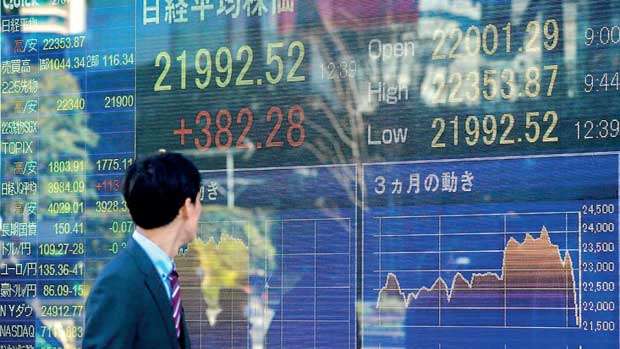07 Apr 2018 - {{hitsCtrl.values.hits}}

REUTERS: Stock markets edged downwards yesterday after U.S. President Donald Trump’s threat to impose an extra US$$100 billion in tariffs on China exacerbated fears of a more serious trade dispute, while the dollar paused ahead of crucial U.S. payrolls data.
European shares followed their Asian counterparts into the red but the falls were limited, and the broader ups and downs for markets this week suggest investors are not yet convinced the row will escalate into a full-blown trade war that threatens global economic growth.
The dollar, which has tended to fall when trade tensions rise, was largely flat but is up half a percent this week.
Britain’s FTSE 100 dropped 0.13 percent while the German Dax was down 0.51 percent and France’s CAC 40 0.48 percent.
The MSCI World Index slipped 0.08 percent, although it had erased most of its earlier losses as markets calmed in European trading. S&P 500 E-mini futures cut their losses to 0.6 percent, pointing to a lower start for Wall Street when it opens.
Yesterday’s U.S. non-farm payrolls report could determine the pace of future Federal Reserve interest rate rises and the dollar’s direction.
Fed chairman Jerome Powell is also speaking yesterday said investors will be looking for any signs that rates could rise more than an expected two further hikes this year. The Fed raised rates last month.
The U.S. March employment report is expected to show non-farm payroll growth of 193,000 jobs versus 313,000 the prior month, according to the latest Thomson Reuters poll of economists.
Average hourly earnings are expected to have risen 0.2 percent last month after edging up 0.1 percent in February. The gain would lift the annual increase in average hourly earnings to 2.7 percent from 2.6 percent in February.
The dollar weakened 0.1 percent against a basket of major currencies with traders reluctant to take big positions ahead of the payrolls numbers.
Against the yen, which as a safe haven currency tends to be among the most sensitive to global economic uncertainty, the dollar was flat. So far this week the dollar is almost 1 percent versus the Japanese currency, hitting its best level since late February, despite the growing U.S.-China trade tensions.
Some Asian currencies showed signs of investor nervousness, however.
The Chinese yuan fell another 0.4 percent versus the dollar, bringing week-to-date losses to 0.8 percent. The Korean won, heavily exposed to global trade, also fell.
Treasury debt prices gained and yields declined as investors sought the safety of government bonds. Euro zone government bond yields also dipped as the trade dispute between the United States and China flared.
The 10-year Treasury note yield fell marginally to 2.8247 percent, pulling back from Thursday’s nine-day high of 2.838 percent. Treasury yields had fallen further in Asian trading but the European open calmed investors.
The yield on 10-year German government debt, the euro zone benchmark, slid 1 basis points in early trade to a shade above 0.51 percent.
Crude oil prices fell after Trump’s latest tariff proposal. O/R U.S. crude slipped 0.44 percent to $63.26 a barrel and Brent was down 0.38 percent at $68.07 a barrel. Gold prices were steady.
18 Nov 2024 4 hours ago
18 Nov 2024 5 hours ago
18 Nov 2024 5 hours ago
18 Nov 2024 6 hours ago
18 Nov 2024 18 Nov 2024